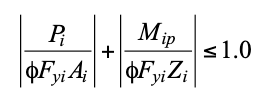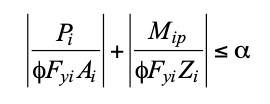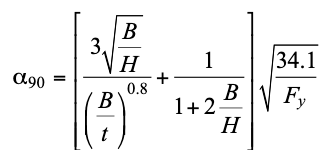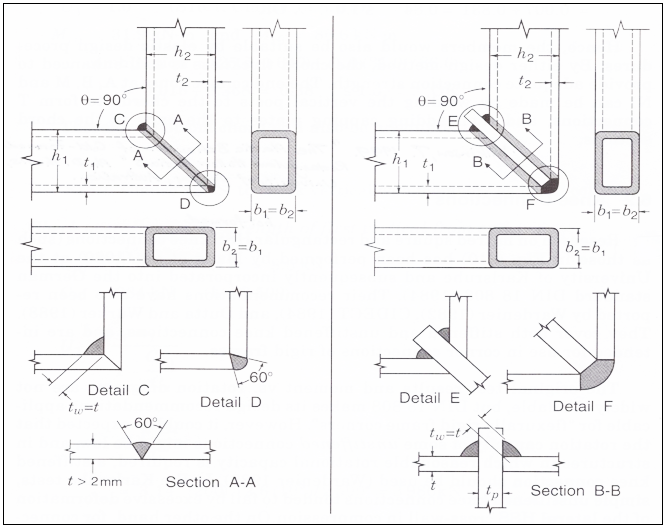HSS Knee Connections
By Jeffrey A. Packer
Bahen/Tanenbaum Professor of Civil Engineering, University of Toronto, Ontario, Canada
Single-story frames can be fabricated by welding round or square/rectangular HSS together, typically with a pitched roof, forming so-called Knee connections as illustrated in Figure 1. Such frames are used in light construction, such as with greenhouses, and as portal frames (Hancock et al., 2005).

Connection Behavior
These planar frame connections are loaded principally in bending, with the moments causing opening or closing of the connection angle. They have a rotational stiffness that generally characterizes them as semi-rigid, or partially restrained (PR), unless the members are stocky and the connection is stiffened. As noted in the AISC 360-16 Specification Section B3.4b(b), the load-deformation response characteristics need to be included in the analysis of the structure. Moreover, PR connections need to have sufficient strength, stiffness and deformation capacity at the strength limit states. In order to investigate these characteristics, research has been performed on this type of moment connection, both stiffened and unstiffened (see Figure 1), particularly in Germany where they are known as “L-joints”. Initially, experimentation was done on rectangular HSS Knee connections (Mang et al., 1980), and later experimental and numerical studies were performed on round HSS Knee connections, both under static and fatigue loading (Mang et al., 1997, 1998; Puthli et al., 1997; Karcher 2001; Karcher and Puthli, 2001). Summaries of the static behavior of Knee connections are given in CIDECT Design Guides 1 (Wardenier et al., 2008) and 3 (Packer et al., 2009), and in Packer and Henderson (1997). Knee connections using German hot-formed square and rectangular HSS, when unstiffened, tended to fail by excessive deformation of the lateral HSS cross-wall in compression. On the other hand, for connections with a stiffening plate excessive deformations only appeared for very thin-walled members; with thicker-walled HSS complete plastification was reached. Subsequent research on cold-formed rectangular HSS Knee connections in Australia (Wilkinson and Hancock, 1998a, 1998b; Wilkinson, 1999) has shown that both unstiffened and plate-stiffened welded Knee connections, meeting the design criteria presented below, do not always have sufficient moment-rotation properties for use in plastically designed frames, particularly under opening moments. Hence, such Knee connections are appropriate only in elastically designed frames. For all the design criteria below, the use of HSS with compact cross sections is required.
Design of Rectangular HSS Knee Connections
Matched-width HSS can be mitered and welded together as illustrated in Figure 2. For the unstiffened case, weld quality and HSS edge preparations are critical. The opportunity to fillet weld to a plate clearly simplifies fabrication for the stiffened connection case, as well as producing a stiffer and stronger connection. Mang et al. (1980) showed that the design of Knee connections could be performed based on a check of the utilization of the HSS capacity under axial load and bending.
For the reinforced case (Figure 1(b)), the connection needs to satisfy, for LRFD (Mang et al., 1980):

where Φ = 0.9, the subscript i = 1 or 2 (pertains to the two members in Figure 1(b)), Mip is the applied in-plane bending moment, and Zi = plastic section modulus of member i about the appropriate bending axis. The thickness of the stiffening plate (Figure 1(b)) is required to be tp ≥ 1.5t and ≥ 3/8 in. Eq. (1) applies to all connection angles, θ. With the stiffened connection, which is preferable, there is the opportunity to have two slightly different rectangular HSS sizes.
For the unreinforced case (Figure 1(a)), the connection degree of utilization is reduced to a factor α ≤ 1.0, according to Eq. (2), for LRFD (Mang et al., 1980):

where, for θ = 90o:

and the orientation of the HSS, to give H and B, is shown in Figure 1(a). The HSS nominal yield stress, Fy, is in units of ksi. For connection angles ≠ 90o,
for 90o < θ ≤ 180o:

which confirms that for obtuse angle connections (θ > 90o) one can take advantage of a strength enhancement. Eqs. (2), (3) and (4) are valid within the ranges: 90o ≤ θ ≤ 180o, 0.5 ≤ B/H ≤ 2.0, 10 ≤ B/t ≤ compact, and also subject to the limits on Pi and Vi (see Figure 1) given by Eqs. (5) and (6):
Pi ≤ 0.2FyiAi
Equation (5)
Vi ≤ 0.3Fyi(2Ht)
Equation (6)

Left Image: (a) Unstiffened | Right Image (b) Plate-stiffened
Design of Round HSS Knee Connections
For the reinforced case (Figure 1(d)), the connection needs to satisfy Eq. (1) for LRFD (Karcher, 2001; Karcher and Puthli, 2001), in the same manner as for rectangular HSS Knee connections. The thickness of the stiffening plate (Figure 1(d)) is required to be tp ≥ 1.5t and ≥ 3/8 in. Eq. (1) again applies to all connection angles, θ. With the stiffened connection, which is preferable, there is the opportunity to have two slightly different round HSS sizes.
For the unreinforced case (Figure 1(c)), the connection degree of utilization is reduced to a factor α ≤ 1.0, according to Eq. (2), for LRFD (Karcher, 2001; Karcher and Puthli, 2001). In Eq. (2),
for 90o ≤ θ ≤ 135o:

with Fy in ksi. Eqs. (2) and (7) are valid within the ranges: 90o ≤ θ ≤ 135o, 8 ≤ D/t ≤ compact, and also subject to the limits on Pi and Vi (see Figure 1) given by Eqs. (5) and (8):

References
AISC. 2016. “Specification for Structural Steel Buildings”, ANSI/AISC 360-16, and Commentary, American Institute of Steel Construction, Chicago, IL.
Hancock, G.J., Wilkinson, T. and Zhao, X.-L. 2005. “Cold-Formed Tubular Members and Connections: Structural Behaviour and Design”, Elsevier, Amsterdam, The Netherlands.
Karcher, D. 2001. “Tragverhalten von Rahmen-ecken aus Rundhohlprofilen”, PhD thesis, University of Karlsruhe, Germany.
Karcher, D. and Puthli, R.S. 2001. “The Static Design of Stiffened and Unstiffened CHS L-Joints”, Proceedings of the 9th. International Symposium on Tubular Structures, Düsseldorf, Germany, pp. 221-228.
Mang. F., Herion, S. and Karcher, D. 1997. “L-Joints made of Circular Hollow Sections”, Final Revised CIDECT Report 5BE-10-96, rev. 1997, University of Karlsruhe, Germany.
Mang, F., Steidl, G. and Bucak, Ö. 1980. “Design of Welded Lattice Joints and Moment Resisting Knee made of Rectangular Hollow Sections”, IIW Doc. XV-436-80, University of Karlsruhe, Germany.
Mang, F., Puthli, R. and Karcher, D. 1998. “Investigations on Stiffened and Unstiffened L-Joints made of Circular Hollow Sections”, Proceedings of the 8th. International Symposium on Tubular Structures, Singapore, pp. 197-202.
Packer, J.A. and Henderson, J.E. 1997. “Hollow Structural Section Connections and Trusses – A Design Guide”, 2nd. edition, Canadian Institute of Steel Construction, Toronto, ON.
Packer, J.A., Wardenier, J., Zhao, X.-L., van der Vegte, G.J. and Kurobane, Y. 2009. “Design Guide for Rectangular Hollow Section (RHS) Joints under Predominantly Static Loading”, CIDECT Design Guide No. 3, 2nd. edition, CIDECT, Geneva, Switzerland.
Puthli, R., Mang, F. and Karcher, D. 1997. “The Static Strength of Stiffened and Unstiffened L-Joints made of Circular Hollow Sections”, Proceedings of the 7th. International Offshore and Polar Engineering Conference, Honolulu, Hawaii, USA.
Wardenier, J., Kurobane, Y., Packer, J.A., van der Vegte, G.J. and Zhao, X.-L. 2008. “Design Guide for Circular Hollow Section (CHS) Joints under Predominantly Static Loading”, CIDECT Design Guide No. 1, 2nd. edition, CIDECT, Geneva, Switzerland.
Wilkinson, T. and Hancock, G.J. 1998a. “Tests of Stiffened and Unstiffened Welded Knee Connections in Cold-Formed RHS”, Proceedings of the 8th. International Symposium on Tubular Structures, Singapore, pp. 177-186.
Wilkinson, T. and Hancock, G.J. 1998b. “Tests of Portal Frames in Cold-Formed RHS”, Proceedings of the 8th. International Symposium on Tubular Structures, Singapore, pp. 521-529.
Wilkinson, T. 1999. “The Plastic Behaviour of Cold-Formed Rectangular Hollow Sections”, Ph.D. thesis, University of Sydney, Australia.
June 2019